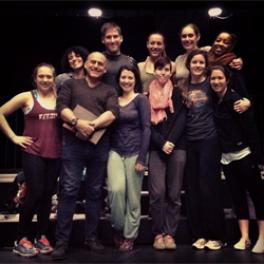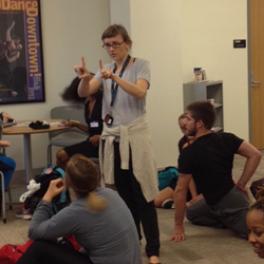Commissioned by the College of Arts and Sciences, choreographer Stephan Koplowitz created a promenade, site-specific and site-inspired performance event to celebrate the grand reopening. Sullivant’s Travels; a journey into the mind of a building was a world premiere of 11 performance works inspired by the history of the building, the architecture and the current use of specific spaces.
Behind the Collaboration
Sarah Levitt, MFA W16

On Sept. 20, 2014, Sullivant’s Travels traversed through Sullivant Hall, the Department of Dance’s newly renovated home. Audiences witnessed dancers leaning over the outdoor balcony on High Street, flying through the rotunda, climbing ropes in Studio 390, rehearsing in 290 and jumping onto the Barnett Theatre’s lighting grid. Audience members became performers themselves at times in interactive elements including a dancing “photo booth.” These are just a few of the performance and participatory sections of Sullivant’s Travels, which incorporated undergraduate, graduate students and faculty members from the Department of Dance, the Advanced Computing Center for the Arts and Design, and the School of Music.
Choreographer Stephan Koplowitz, internationally known for his site-specific performances, led the six-month, highly collaborative process of creating this work, assisted closely by faculty member Ann Sofie Clemmensen. Stephan and Sofie selected a small company of graduate and undergraduate students in spring 2014 to create movement material and try out ideas in the various sites that would be taught to the rest of the ensemble in May and August.
In our early rehearsals, Stephan gave us movement prompts in various sites, usually starting with one task and quickly layering on more ideas. Following closely behind these instructions from Stephan was Sofie, carefully crafting and cleaning his vision until each section shined.

At one point in August, I joined Sofie on the first floor of the rotunda as she rehearsed dancers on the second and third floors. The rotunda section, in which dancers continually rotated, was extremely challenging. Dancers had to coordinate their timing exactly with dancers across from them, next to them, and above or below them, finding a group timing that didn’t necessarily rely on being able to see everyone at once. Sofie started the dancers and stopped them, clarified counts, questioned a pathway, started and stopped again. Sofie could see the big picture of the whole dance, and knew that the details weren’t just important to the dance, they were the dance.
The process of arriving at Sept. 20 was far from smooth, but it strikes me that smooth, even and steady creates a certain kind of dance. Our process — messy, unpredictable, unwieldy — created a dance that really reflected the daily life of Sullivant Hall over the years. It highlighted the artistic processes that have taken place in this building, the people who built their lives here and the daily decision to make art, no matter the circumstances. Stephan and Sofie were tireless leaders, and their efforts together created an event that still resonates in the studios and halls of Sullivant.
